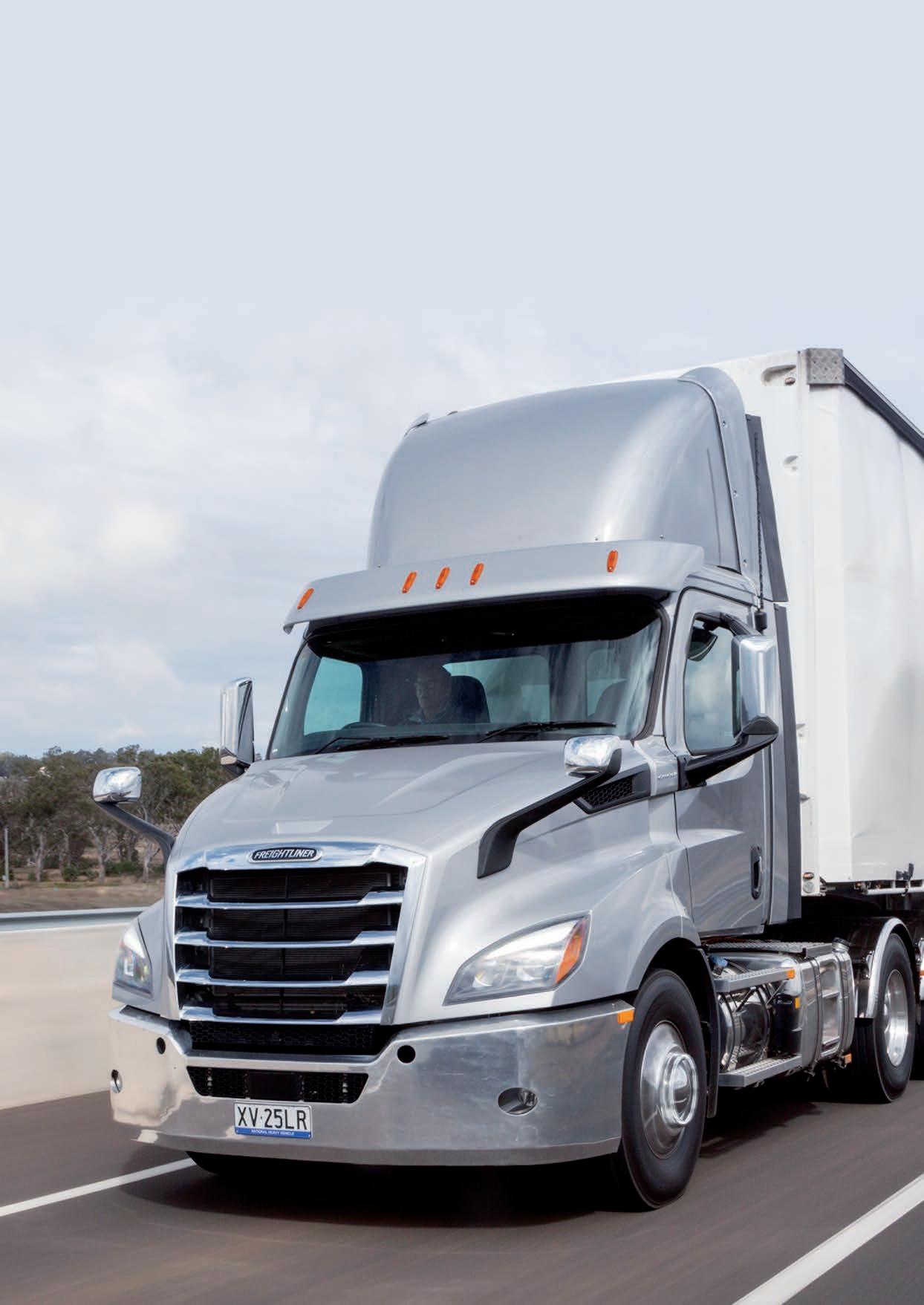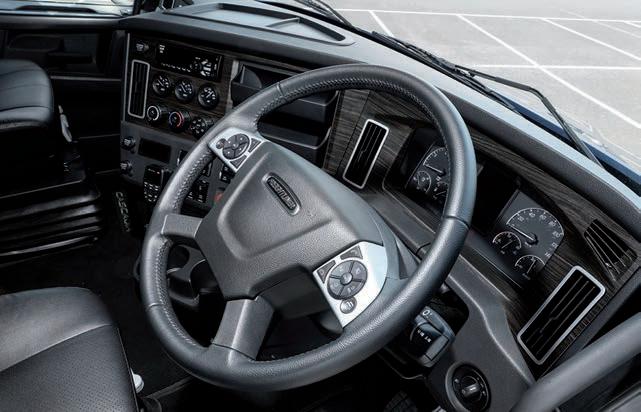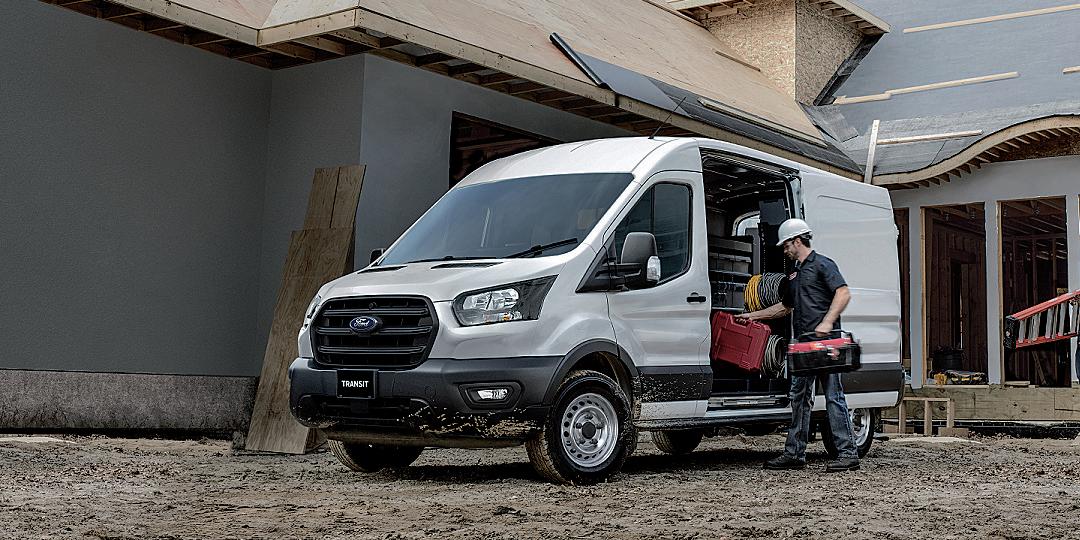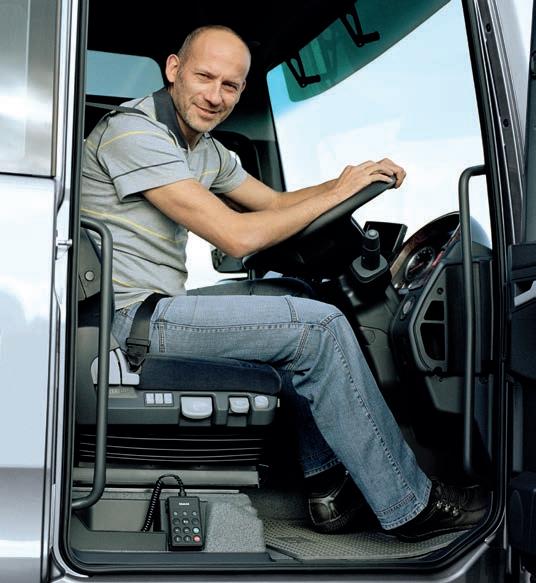
17 minute read
The Conventional Revolution
THE CONVENTIONAL REVOL

North America’s best-selling and most advanced heavy duty truck is now available in Australia and New Zealand.
A Detroit DD13 delivers power and torque figures formerly associated with much larger engines.
UTION
There has been much written about the Freightliner Cascadia, and with good reason. The Cascadia holds a dominating 40 per cent of US ‘Class 8’ market which is the equivalent to our own Heavy Duty sector, and after being subjected to comprehensive bumper to tail light engineering reviews and the most exhaustive truck testing regime imaginable, America’s most advanced conventional cab truck is now available in Australia and New Zealand. The claimed investment of $100 million to develop and refine the already ultrasuccessful Cascadia for the Australian and New Zealand markets appears from every aspect to have been well spent and a good investment. At various times throughout the development of the Cascadia for the Australian market, Prime Mover has driven left hand drive versions in Australia and right hand drive Cascadia’s in the US so we have a degree of positive anticipation about this opportunity

Cascadia uses a ‘road reading’ Intelligent Powertrain Management. to operate the truck with the steering wheel on the ‘correct’ side of the road. For the purposes of road assessments by some fleets and the Australian media, this particular daycab Cascadia has been connected in both B-double and single trailer configurations. We opt for a single trailer set-up for sections of the route which includes roads on which B-doubles are not permitted. The route taken is an eclectic mix of New South Wales highways and country roads, culminating in the testing haul up the west face of Mount Victoria before descending the more gentle slope on the east side of the Blue Mountains escarpment. The 13 litre DD13 engine has the power/ torque figures of 505hp and 1850 lb-ft which only a few years ago would have been considered good specifications from a 15 litre engine. The advanced level of sophistication of the fuel control systems has resulted in the usable torque becoming available at significantly low crankshaft revolutions. Maximum torque is available at 975rpm. This allows for the implementation of lower numerical ratio final drives to result in down speeding of the engine with the benefit of improved fuel efficiency and lower exhaust emissions. As it already exceeds the stricter US GHG 17 emission standards, the engine comfortably meets Euro 6 standards despite them not being mandated here yet. In addition to being very effective, the three stage engine brake is much quieter than expected and operates harmoniously with the Descent Control function to keep vehicle speed in check on downhill runs. The transmission is the automated DT12 driving through Meritor driveshafts and
The Freightliner Cascadia has the flexibility to operate in most PBS combinations.

diffs. Our test combination has a gross weight just under 41 tonnes and at every point of the 460 kilometre test loop there is confidence that the right ratio is selected, even on the short but very steep ascent up from the flooding Abercrombie River gorge and the longer climb of Mount Victoria, thanks in part to the Cascadia’s GPS-based and ‘road reading’ Intelligent Powertrain Management. An 18-speed Eaton manual transmission is available as an option. The Freightliner AirLiner rear suspension rides smooth over the differing surfaces which is no surprise to us having witnessed the pounding Cascadia test trucks endured on the exaggerated corrugations of the Daimler Trucks test centre in Madras, Oregon. Freightliner has made an applaudable decision to include many advanced safety features as standard equipment on the Australian-delivered Cascadia’s including the fully-integrated Detroit Assurance 5.0 which uses radar and high definition camera technology for Active Emergency Braking and to facilitate the Active Cruise Control. The system has the capability to detect a slower or stationary vehicle or even pedestrians, and in an emergency the Autonomous Emergency Braking can quickly bring the truck to a complete stop with no input from the driver. Tailgate warning, lane departure warning, intelligent (self-dipping) high beam and automatic wipers and headlamps are all also standard equipment, as are the expected anti-skid brakes, traction control and Electronic Stability Control. The Sideguard Assist system uses two short-range radars (one aiming forward and one aiming back) on the kerbside to warn the driver of potential trailer collisions with objects such as utility poles or street signs when turning left (Trailer Sweep Assist) and, also warns the driver if they are about to merge left into an lane already occupied (Turn Assist). This blind spot safety system uses audio warnings as well as a yellow light on the kerbside A pillar to alert the driver of a potential collision. The Cascadia has tapered frame rails which provide the double benefits of a lower centre of gravity plus a lower and flatter cab floor. This test truck is the Cascadia 116 daycab. It’s easy to get in and out of, and is comfortably spacious despite not being a sleeper. The 116 nomenclature refers to the crucial bumper to back of cab (BBC) measurement which on this model is 116 inches or 2,970 mm which provides the flexibility for operating as a maximum length B-double or in most PBS combinations. The interior ergonomics associated with the Cascadia’s operation are impressive as the instruments, controls and switches set out in a manner that is logical and readily accessible. Forward vision through the one-piece windscreen is extensive thanks to the sloping bonnet. The use of the single piece screen has aerodynamic benefits and permits the use of conventional channel rubbers to locate the screen which makes replacement more straightforward and avoids the time required for chemical seals to ‘cure’, meaning off-road time is minimised. The batteries are positioned under the passenger seat and Freightliner offer other location options including behind the cab or between the chassis rails. Aerodynamics to save fuel are a major factor in the design of the cab which also benefits from good insulation to smooth out external temperature extremes and reduce noise in the interior. Triple door seals contribute to the exclusion of outside noises in addition to their primary function of keeping out dust and moisture. The Cascadia has a corrosion resistant alloy cab fitted with steel doors which meets the ECE R29 cab strength criteria. Good design and manufacturing results in a cab free from squeaks or rattles which is just as well due to the quiet ambience of the cab. The source of the only rattle detectable in this truck (which has travelled around 25,000 kilometers) is quickly determined to be due to the temporary installation of an aftermarket communication component rather than anything to do with Freightliner’s design or manufacturing processes. Freightliner’s technical expertise results in the successful integration of Europeanlike sophistication into an unmistakably American-style conventional truck and has given local operators the very best features of both, with negligible compromises. In order to extract the most benefit from this level of sophistication Freightliner are providing a complimentary driver training program with each new sale which highlights the key elements of maximising driver experience, vehicle safety and fuel efficiency. High profile local fleets including Linfox and McColl’s have been among the first in Australia to take delivery of the Cascadia.
GAINS ARTICULATED
ADVERTISE IN OUR DECEMBER 2020 PROMOTIONAL FEATURE.
Under Performance-Based Standards more commonly known as PBS, heavy vehicle productity has been transformed in Australia. Despite the many detailed requirements the concept of PBS is simple. Operators and manufacturers are empowered to develop vehicles that meet a series of performance based criteria such as swept path, tracking stability, group and combination axle loadings, startability and gradeability meaning they are no longer bound to prescriptive regulations that define length, width and mass of trucks and trailers. In the new era of high performance freight vehicles (HPFVs) Prime Behind the people who Mover looks at the latest developments in the keep Australia moving Everything we do, every day, relies on the people who literally keep Australia moving. From the fresh food in our supermarkets, to the petrol in our cars, from the school bus, to the train you catch to PBS phenomenon and how these innovations work, even your holiday travel. None of it would happen without transport workers. And behind them is TWUSUPER, the industry super fund for the people who look after you.

have brought about major advantages for 1800 222 071 twusuper.com.au
operators, OEMs and industry. SUPERRATINGS GOLD 2019 MYCHOICE SUPER SUPERRATINGS GOLD 2019 PENSION TWU Nominees Pty Ltd, ABN 67 002 835 412, AFSL 239163, is the trustee of TWUSUPER ABN 77 343 563 307 and the issuer of interests in it. 55621
BOOKING DEADLINE 23 OCT 2020
October 2020

OCTOBER 2020
primemovermag.com.au ACFS Port Logistics Frontline Reinforcements
OCTOBER 2020 $11.00
ISSN 1838-2320 09
9 771838 232000 Industry Fleet: Everstin Group Feature: SEQ Ice Cream Spotlight: JCM Spreading Personality: Paul Graham Innovation Fleet: Brooks Hire Service Technology: Vehicle Stability Control Test Drive: Freightliner Cascadia 116 Final Mile: Ford Transit
THE PEOPLE & PRODUCTS THAT MAKE TRANSPORT MOVE
TO BOOK IN PRIME MOVER CONTACT ASHLEY BLACHFORD NOW
SOUL RUBBER
It seems the Ford Transit has been around forever and has earned its place in the popular lexicon as the generic term for all vans of its type.
‘N ext-Gen’ is a term that is often inappropriately used but Ford’s application of it to the latest Transit van range is well and truly justified. Over the past 55 years the Transit has developed from a box on wheels with a wheezy V4 engine in 1965 to the stylish, pleasure-to-drive and practical vehicle it is today. The 2020 Transit is now loaded with technology in addition to having undergone a style make-over including a contemporary front area with sleek headlamps. As with the Ford Ranger utilities, Ford now includes, as standard equipment, the Driver Assist Technology package in the Transit. This includes Autonomous Emergency Braking (AEB) and Pedestrian Detection (PD), Adaptive Cruise Control and Lane Departure Warning. Vans such as the Transit are likely to have applications involving deliveries to addresses in places such as pedestrian malls so the AEB and PD provide practical support to drivers negotiating areas of high pedestrian traffic. The Dynamic Stability Control system includes functions to address cross winds and trailer sway. The
Optional high roof configuration takes cargo capacity to 8.3 cubic metres.

Adaptive Cruise Control and the PreCollision Assist are driver confidence boosters and the Lane Departure Warning provides audio and physical alerts if the driver allows the Transit to wander out of its lane. A benefit of the electric power steering is the ability to vibrate the steering wheel in these circumstances in case the driver ignores the audible warnings. In a solid sided van such as the Transit, even with good mirrors, blind spots can still be a problem, especially in traffic. The Transit’s Blind Spot Information System detects any vehicle potentially in either side’s blind spots and alerts the driver by activating a warning indicator in the side mirror. The Next-Gen Transit has a new dash, much of it similar to the Ford Fiesta passenger cars and includes updated instruments and control and switch panels with an 8.0 inch colour touch screen. Voice activated Bluetooth connection, Apple CarPlay and Android Auto are included in the package along with a rear view camera and front and rear parking sensors. Satellite navigation is a $600 option. The front compartment has six airbags
and the Transit range receives a five star ANCAP rating. A trick function is embedded in the Transit which automatically dials 000 and provides the vehicle’s co-ordinates if the airbags are deployed. Automatic headlamps and windscreen wipers are also standard. The front doors have wide openings and wide steps that facilitate easy access to the new design seating, which has cloth trim and electric heating on the outboard seats. In-cab storage is plentiful including two large bins located on top of the dash and goodsized bins plus bottle holders in the doors. The passenger seat can be flipped up to expose another ‘away from prying eyes’ compartment for laptops and valuable items such as power tools. The Transit Custom is able to accommodate a 3.4 metre load length while the larger Transit Van models can handle items up to 4.2 metres. A full width bulkhead behind the seats serves as a safety barrier and also enhances the efficiency of the air conditioning and heating system due to it only being required to maintain comfort levels in the smaller space of the passenger compartment. The cargo section has numerous tie down anchor points, full flooring and is fully lined to roof height. Standard door arrangements are a kerbside slider and barn doors at the rear, with options including a driver’s side slider and lift up tailgate at the rear. The optional high roof configurations take the Transit Custom’s cargo capacity to 8.3 cubic metres and the Transit Van’s interior load volume to 13.0 cubic metres. USB connections are expected in modern work vehicles and the Transit has two. Where the Transit over-delivers is in the provision of a 230volt 150watt invertor (400watt in some models) which is a great feature for tradies. The standard driveline is now the 2.0

The cargo section now features multiple tie down anchor points.
Standard driveline is a 2.0 litre 125kW Ford EcoBlue turbo engine.

litre 125kW/390Nm Ford ‘EcoBlue’ engine with a variable geometry turbo which meets the latest Euro 6.2 emissions standards. In contrast, the Transit Custom Sport model gets a tweaked version with 136kW/405Nm. The engine has a stop-start function to save fuel. The transmission is an easy shifting six-speed manual on the rear wheel drive models with an option for a six-speed torque convertor automatic available in the front wheel drive Transits. A ten-speed auto is also available in selected models. The Transit range offers a 12 month/30,000 km service interval and a five-year warranty with unlimited kilometres. The AdBlue tank has a capacity of 21 litres. Rear wheel drive models have 95 litre fuel tanks, with the front wheel drive automatics being fitted with a smaller 72 litre diesel tank. Brakes are discs all round and the suspension is McPherson struts at the front and leaf springs and shock absorbers at the rear. In a market strongly populated by European and Asian vans, the Ford Transit, with its incorporation of robust engineering and myriad innovative features, holds its own. The standard fitment of the very comprehensive safety package is commendable and will be an important consideration in applications with a strong WHS influence.
GRAND
Improved productivity was always a key reason for the establishment of the National Heavy Vehicle Regulator. Having expanded its influence and capabilities for almost eight years it has now developed its own plan to help provide benefits to much of the road transport industry.
The National Heavy Vehicle Productivity Commission’s Inquiry into government associations in participating Regulator (NHVR) has been National Transport Regulatory Reform, the jurisdictions,” says Don Hogben NHVR in operation since early 2013 NHVR has embarked on developing its Chief Regulatory and Standards Officer. and after an acknowledged own plan aimed at improved productivity. The NHVR’s Plan involves seeking new troubled start, which saw it overwhelmed NHVR’s Heavy Vehicle Productivity Plan opportunities to improve access and in its attempts to manage the role of 2020–2025 (the Plan), outlines the productivity under the current HVNL but issuing OSOM permits, the Regulator objectives, goals and actions to deliver the Plan has been deliberately infused regrouped under second CEO Sal safe, efficient and productive heavy with the flexibility to adapt to any Petroccitto and in the ensuing years has vehicle operations. In developing the legislative changes which may occur in progressively increased its operational Plan, as it has for most of its existence, the future. footprint including assuming the onthe NHVR admirably undertook The Plan has three major objectives. road enforcement role in a number of significant engagement with industry Objective 1: Provide access certainty and states. One of the original intentions in and government agencies at all levels in consistency; Objective 2: Partner with establishing the NHVR was to improve an effort to ensure the Plan ultimately local government to build capability; road transport productivity by aligning reflects the contributions and needs of and Objective 3: Promote safer and more regulations within participating states multiple stakeholders in the industry, productive heavy vehicles which are better with a ‘one nation, one rulebook’ while pursuing improvements in for the environment and communities. approach. As work towards that once lofty heavy vehicle productivity that are Each objective contains goals which are goal continues to play out, the NHVR recognised and valued by general society, key elements to delivering on the intent of is able to focus some of its attention on governments and industries. the Plan, and in turn, actions considered considering the details of indeed how “We engaged with 55 stakeholders in necessary to achieve the desired outcomes productivity in the road transport sector pre-submission consultation, received 23 are suggested and prioritised. can be enhanced. formal submissions, presented a webinar During the consultation process priority While the industry waits for the outcome with 178 registered participants, and held actions were identified with shared of the National Transport Commission’s nine workshops with the Commonwealth importance among governments and review of the Heavy Vehicle National Government, all state and territory industry which will deliver the greatest Law Act 2012 (HVNL), as well as the transport agencies and all local benefit to access and productivity.
A unique multi-combination vehicle passes through Townsville.

Image credit: Cam Laird / Shutterstock.com
DESIGNS
Don Hogben NHVR Chief Regulatory and Standards Officer.

Fundamentally, these priority actions can be categorised as contributing to increasing the coverage of notices and gazetted and pre-approved networks, improving the Performance-Based Standards (PBS) scheme, and helping governments make more-informed decisions. The plan identifies a number of ‘short term’ actions with a timeline of one to two years which include the targeted elimination of access permits by encouraging road managers to expand gazetted and pre-approved networks through enhanced data-sharing solutions for historic access permit approvals. To support improved government and industry decision-making, the NHVR Plan includes developing an access permit data hub which analyses and visualises historic access permit outcomes by road for different vehicle types. The Plan also aims for the provision for greater access and certainty for PBS vehicles and to encourage road managers to expand gazetted and pre-approved PBS networks through enhanced data-sharing solutions for historic PBS access permit approvals and PBS vehicle designs. To further assist road managers in making informed decisions, under the Plan the NHVR will continue to deliver and expand the range of education and training material available and will continue to facilitate forums, workshops and online training for council engineers and road managers. This will also involve the NHVR continuing to facilitate engagement opportunities between road managers and industry to build relationships and enable collaboration leading to mutually beneficial outcomes. Medium term (2-4 years) objectives of the Plan include the development of a national mapping solution for heavy vehicle access and the continued review and promotion of the PBS scheme. Significantly, the Plan directs that during the medium and long term periods (4+ years) the NHVR will develop a Vehicle Safety and Environmental Technology Uptake Plan to accelerate and incentivise the uptake of safety and environmental technology in the heavy vehicle fleet. This presents a genuine opportunity for the Commonwealth Government to incentivise the uptake of modern vehicles with the latest safety and environmental technologies and reduce the average age of the national road transport fleet. As a reformist organisation, the NHVR is uniquely positioned to support a national approach to addressing Australia’s rising road freight task, which prior to COVID-19 was growing twice as fast as the population and has been predicted by a number of institutions to grow by 80 per cent during the period 2010-2030. The difficulties surrounding the COVID-19 pandemic have again highlighted that ‘without trucks, Australia stops’ and the NHVR’s Plan is a de-politicised callto-action that provides in detail the necessary steps required to maintain, and even improve, efficiency and productivity in whatever the road transport environment is faced with during the next decade and beyond.







